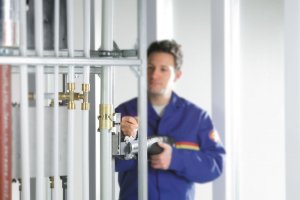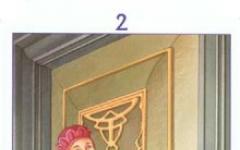Ventilation ensures air flow and circulation of air masses, thereby reducing the concentration of bacteria and normalizing humidity.
Types of internal ventilation
There are natural and artificial ventilation. Natural is based on factors environment: wind, pressure and temperature differences. For artificial, it is necessary to install specialized equipment (fans, heaters, valves, filters, etc.). The advantage of the natural system is its simplicity, reliability, durability and low cost. The main disadvantage is the lack of regulation and dependence on natural factors.
There are local and general ventilation. Local regulates the supply and exhaust of air in an isolated space or in certain area. It is used where the room with polluted air is localized, for example, catering kitchens or in production workshops. The general exchange ventilates the entire room and creates the same conditions everywhere.
Based on the method of supplying and removing air, it is customary to divide ventilation systems into: supply and exhaust. Supply ventilation serves to supply air into the building. The exhaust system removes waste or polluted air from the room. For the best effect, it is advisable to install both types of systems.
Anti-smoke ventilation is installed in accordance with SNiP 41-01-2003 and is designed to supply air during the initial stage of a fire for the safe evacuation of people. It must be completely autonomous in order to direct oxygen to staircases, elevators and remove combustion products.
Ventilation systems can also be divided into stacked, consisting of various elements, and monoblock, in the form of a single insulated box.
But, no matter what ventilation system you choose, the main thing is to correctly design, install, maintain and monitor its operation. Only then will you receive a complete and effective system.
Types of air conditioning
Air conditioning is part of the internal engineering systems. There are two main types of conditioning:
- Cooled air enters through ventilation. In this case, the cooling section connected to the refrigeration unit is located inside the air duct.
- Cold air comes directly from the indoor unit of the air conditioner (split system), connected to one or more outdoor units.
Multi-zone air conditioning is carried out by connecting several split systems to one external unit. An alternative to a multi split system is a chiller-fan coil. This system is often used in industrial facilities. Chiller is a refrigeration unit installed on the roof of a building. It cools the coolant entering the fan coil units. Fan coil is an indoor unit. It works in the cold from the chiller and cools the air in the room.
Installation of several systems at once, for example, split system, chiller-fan coil, cooling using forced ventilation, is called “central cooling supply”. This multi-component system is relevant for cooling large or architecturally complex structures.
Water supply
The internal water supply system serves to supply water continuously and distribute it indoors.
In the process of designing and installing a water supply, it is important to correctly calculate all components of the system (pipeline and fittings, water meter unit, installations for increasing water pressure, specialized water tanks), select the optimal equipment and install communications in accordance with the regulatory requirements of SNiP.
The final stage of water supply installation work is system testing and commissioning. After hydraulic tests, a work certificate is signed.
Electricity supply
The Novy Posad company carries out design, installation, commissioning of internal electrical networks of the building and electrical switchboards, maintenance of power supply, lighting and grounding systems.
The work process takes place in several stages. At the start, our company’s engineers conduct a site inspection, select optimal solution, meeting the customer’s wishes and regulatory requirements, they create a design for the placement of all elements of the power supply system. This is followed by the installation of new equipment or replacement of old equipment, assembly, laying of networks and communication elements.
Internal engineering networks are a system that ensures the full functioning of the building. When constructing structures, it is important not only how well they are built, but also how well the installation of engineering systems is carried out. It is thanks to a responsible and competent approach to this issue that the building will be effectively operated.
LLC will install internal engineering systems in residential and non-residential buildings under construction and subject to reconstruction in Moscow.
What kind of work do we do?
The most common installations of engineering systems are:
- ventilation - supply, exhaust, supply and exhaust, natural and smoke control;
- air conditioning - split and multi-split systems, chiller-fan coil;
- sewerage - domestic type for residential buildings and industrial for industrial enterprises;
- heating - water, air, electric, "warm floors". Boiler room equipment can be pre-installed for the system;
- water supply: domestic and drinking, industrial and fire-fighting;
- devices for metering resource consumption: water, heat, electricity, gas;
- electrical installation of outdoor lighting (various lamps and lamps).
An employee who specializes in a specific area is responsible for each individual type of engineering systems.
How does this happen?
Any installation of building engineering systems begins with a project. It helps to resolve some controversial issues, significantly save time on coordinating issues and money on purchasing materials necessary for work.
If a building is being constructed, installation occurs in several stages along its entire length. The project is also important because even systems that differ in functionality are closely intertwined with each other. For example, heating requires electricity. Therefore, it is advisable to decide in advance what is needed and where it will happen.
 The likelihood of risks arising depends on how well the construction of house systems is carried out. Many years of experience demonstrate that it is better not to skimp on this. The better the service and materials used, the more trouble-free further operation will be. As a client, here you receive financial benefits and simplified planning of expenses for maintaining the functionality of the building.
The likelihood of risks arising depends on how well the construction of house systems is carried out. Many years of experience demonstrate that it is better not to skimp on this. The better the service and materials used, the more trouble-free further operation will be. As a client, here you receive financial benefits and simplified planning of expenses for maintaining the functionality of the building.
Installation of engineering systems of buildings and structures with Rem Group is profitable investment. We use equipment and materials from famous manufacturing plants. Maintenance is carried out using modern technologies. We strictly comply with the standards and norms established on the territory of the Russian Federation.
The cost depends on the volume and specifics of the work. Find out more by visiting our office in Moscow, or fill out the feedback form, and managers will be sure to answer all questions as soon as possible.
Write to us
It is impossible to imagine a modern building without large quantity engineering systems. Every year, the design of engineering systems takes up an increasing part of the volume. And the higher the class of the building, the more interesting the task of designing utility networks.
Design of internal engineering systems and external networks. Obtaining technical specifications.
Engineering design of buildings always begins with the collection of loads to obtain technical conditions for connections. It is important to imagine at the start how the building will be equipped, and, based on these data, it is necessary to determine the required power supply capacity, the required amount of water for water supply (including for fire needs), the amount of domestic and storm drains, the required volumes of heat supply for heating and hot water needs. It would seem so easy to lay down a reserve, but it is impossible; the Customer will pay for every extra kilowatt or cubic meter. The opposite situation is when the loads in the technical conditions obtained at the stage Draft design, was not enough, is also completely unacceptable. Only extensive experience, skills in calculation methods and close cooperation with the Customer make it possible to obtain optimal technical conditions the first time.
Building engineering systems
Since there are quite a lot of systems, the following issues are always addressed during design:
- Location technical premises(ventilation chambers, transformer substations, water metering units, individual heating points, etc.). On the one hand, the volume of these premises should be sufficient for convenient placement and maintenance of the necessary installations, and on the other hand, it should not be too large, because every square meter technical premises reduces the usable area of the building;
- Minimizing the lengths and dimensions of communications due to correct location technical premises. The closer the rooms are located to the center of the loads, the smaller the dimensions of the air ducts, pipe diameters, cable sections, etc.;
- The location of vertical communications in shafts, horizontal - in corridors in the ceiling space. There should be enough space for installation and maintenance of systems, but, again, it is necessary to observe the principle of reasonable sufficiency and not waste precious meters of usable area and free height of the premises.
Core networks and systems
The following are the main engineering systems of most buildings:

Internal and external engineering systems
Engineering systems design consists of designing internal systems and, as a rule, involves the design of external networks.
In order to avoid installation problems during the design of internal engineering networks, it is important to link the various systems with each other and with load-bearing structures building. Previously, this painstaking process was carried out almost manually by performing combined floor plans engineering systems, as well as constructing sections at characteristic locations of each floor of the building. Today, competent designers using parametric or , have the opportunity to combine networks by connecting models of different systems into one using a special format for data exchange - IFC.
 By building accurate models of each system and then combining them, 3D engineering modeling allows you to track and eliminate mutual intersections at the earliest stages of design. To assemble a summary model from models (), (), (design of utilities), programs such as Solibri and Tekla BIM Sight are used. Having loaded all the necessary models, you can search for intersections in automatic and manual modes, and visually verify the ability to mount each of the systems. The result of the mutual linking of networks is the assignment of holes and openings for designing structures.
By building accurate models of each system and then combining them, 3D engineering modeling allows you to track and eliminate mutual intersections at the earliest stages of design. To assemble a summary model from models (), (), (design of utilities), programs such as Solibri and Tekla BIM Sight are used. Having loaded all the necessary models, you can search for intersections in automatic and manual modes, and visually verify the ability to mount each of the systems. The result of the mutual linking of networks is the assignment of holes and openings for designing structures.
The design of external engineering networks and communications will be carried out in specialized software systems (Geonics), and can also be done in classic AutoCAD. At intersection points, distances of at least standard distances must be ensured between such networks as sewerage, water supply (drinking and fire), heating networks, electrical networks, communication networks, etc. When connecting external networks, the nature of the terrain and the amount of seasonal freezing of the soil play an important role. It is important to lay networks when working together with designers in such a way as to ensure a balance of earth masses within the site. When designing external engineering networks, a consolidated network plan is drawn up, on which the horizontal distances between mutually interconnected networks are re-checked, including the distances to buildings and structures.
Engineering design cost
The cost of designing utility networks can vary significantly and amount to 25-40% of the cost of complex design; in financial terms it is 600-1200 rubles/m2 depending on the type of building and the complexity of the systems being designed. The cost of designing engineering systems may depend on the expected design time frame. For example, we can complete a design under tight deadlines, working overtime, and the cost of completing the work increases accordingly.
Economics and optimization of engineering design
 Of course it's complex engineering design must be economical. Transformers, main switchboards, ventilation units, chillers, etc. there should be exactly as much as is needed for the normal operation of the building, and cables, pipelines and air ducts must be optimally selected to ensure the transfer of the resource in question with the required quality to the direct consumer with minimal energy consumption. Next, you need to decide what your savings goals are and what type of savings is needed. In the short term, it will be more economical to use inexpensive simple equipment; the other side of the coin will be increased costs for power supply during operation, possible more frequent repairs or failure of a particular system. When using more expensive equipment, for example with frequency regulation, the initial investment will be slightly higher, but during operation, the cost of power supply for such installations will be 10-30% lower than that of cheaper analogues, and the likelihood of possible failures will also be less.
Of course it's complex engineering design must be economical. Transformers, main switchboards, ventilation units, chillers, etc. there should be exactly as much as is needed for the normal operation of the building, and cables, pipelines and air ducts must be optimally selected to ensure the transfer of the resource in question with the required quality to the direct consumer with minimal energy consumption. Next, you need to decide what your savings goals are and what type of savings is needed. In the short term, it will be more economical to use inexpensive simple equipment; the other side of the coin will be increased costs for power supply during operation, possible more frequent repairs or failure of a particular system. When using more expensive equipment, for example with frequency regulation, the initial investment will be slightly higher, but during operation, the cost of power supply for such installations will be 10-30% lower than that of cheaper analogues, and the likelihood of possible failures will also be less.
Order a service or get a consultation
Write to us
In general, as mentioned above, it is necessary to ensure a rational arrangement of equipment in the building and on the site, and it is also necessary to perform accurate calculations of the required costs and capacities for each system, intelligently and reasonably operating with each coefficient involved in the calculations.
BIM design in REVIT
What does it look like?
For a visual representation of how to use BIM model without installing Revit, you can look at these links (a master plan with all the networks would be very heavy, so we downloaded individual systems).
Object - underground parking residential complex"Composers' Residence".
Wait for it to load, you can rotate it, enlarge it, and by selecting an element and right-clicking on “properties”, you can see what kind of element it is.
Ventilation
Heating and heat supply
Firefighting
Water supply
Sewerage
You should see a window like this:
Key concepts in BIM
Everyone knows that BIM(from the English building information model) is a three-dimensional 3D design. It does not simply use lines and inscriptions, and the designer’s intention is not stored in his head, as was the case when using a drawing board or Autocad. Now all the information is embedded in each element (its labeling, description, characteristics), and each element is associated with each one.
I like to compare BIM design with Excel. They have a lot in common:
- You change something in one cell, and everything changes automatically. Also in Revit.
- In order for an Excel spreadsheet to save you time in the future, you need to do everything correctly and accurately from the very beginning. Also in Revit, spend time at the beginning of the project, but then everything will go faster.
- In both Excel and Revit, you can easily find and track errors.

The point of BIM design is not even the convenience of designers or clarity - but incomparably more carefully developed documentation, according to which construction can be carried out.
Perhaps you need to know a few more concepts.
LOD(Levels of Development) - level of detail of the model. This is how fully the product is drawn. LOD 100 gives only conditional dimensions of the product. LOD 400 - a complete overview of the product. 
LOI(Levels of Information) - level of the information model.
For example, LOI 100 is an exhaust fan. LOI 400 - exhaust fan VR-300-45-3.15, 1500 rpm, engine power 1.5 kW, rotation side - left, air flow 1250 m3/h.
Our objects
We trained Revit engineering staff in 2014, however, we were unable to switch to BIM design without a professional BIM manager. Each designer worked out some nodes or complex areas of the project for himself, but we did not release a full-fledged project.
Only after a BIM manager appeared on the team did design become possible.
One example of development working documentation in Revit - the underground part of the residential complex "Residence of Composers", second stage.

With proper design in Revit, conflicts between engineering systems are eliminated, since all communications are fully coordinated at the design stage. Using a special software tool, all intersections of engineering systems are identified at a very early stage.

The use of 3D design allows you to obtain a detailed specification, including elements that, according to Russian GOSTs, are not shown in the specification (for example, shaped products). Also, automatic calculation of the specification eliminates unjustified overestimation of the volume of upcoming work.

When designing in 3D, it is easy to understand the intricacies of communications on a construction site. If necessary, using free applications (without purchasing Revit), you can rotate, enlarge and print any node.

You can see how you can use the model without installing Revit using these links (a master plan with all the networks would be very heavy, so we downloaded individual systems):
Ventilation
Heating and heat supply
Firefighting
Water supply
Sewerage
If the files do not download, copy the link and paste it into your browser.
How to spot a bad model
Here are some examples showing how to spot a poorly executed Revit model.
1. Lack of information for each element
Often designers use conditional elements from standard set Revit, rather than using a model of the specific real product used in the project. Designers do not bother to prepare models for a specific manufacturer. As a result, the elements are information poor and essentially useless.
In the picture you can see what a standard valve looks like in Revit (highlighted in blue). Please note that there is no product information other than dimensions. 
And here’s what the reinforcement should look like (in blue) according to all the rules. You can see how the crane is drawn in detail, and the table contains all the information: manufacturer, model, dimensions, etc. 
2. The elements are not connected to each other.
Using the Show Disconnects tool, Revit will show all elements that are not connected to each other. As in the example below.

3. 2D elements instead of a full 3D model.
Sometimes designers even use 2D elements in the model.
In Fig. you can see how simply the sink is made.

4. Instead of a product, a simple geometric figure is used.
Sometimes, in order to simplify work, designers can “draw” a figure instead of even a standard element. In this case, a simple parallelepiped is used as a counter. 
BIM design price
We do not increase the cost of the project if we complete it in Revit. There are not many companies on the market who perform work in Revit, but this is not a reason to raise prices, in our opinion.
Project cost calculator
Free estimate. All types of buildings. Prices 2015.
Here is an example for a residential building of 3,000 sq.m.
To calculate other objects you need to register.
| section name | city rates | commercial rates | ||||
|---|---|---|---|---|---|---|
| P+RD | P | RD | P+RD | P | RD | |
| General plan | 127 935 | 51 174 | 76 761 | 0 | 0 | 0 |
| Improvement | 78 412 | 31 365 | 47 047 | 0 | 0 | 0 |
| Relief organization | 148 570 | 59 428 | 89 142 | 0 | 0 | 0 |
| Architectural section | 1 163 795 | 465 518 | 698 277 | 0 | 0 | 0 |
| Structural section | 1 357 761 | 543 104 | 814 656 | 0 | 0 | 0 |
| Technological solutions | 0 | 0 | 0 | 0 | 0 | 0 |
| Heating, ventilation | 293 012 | 117 205 | 175 807 | 0 | 0 | 0 |
| Water supply and sewerage | 259 997 | 103 999 | 155 998 | 0 | 0 | 0 |
| Power supply and lighting | 218 727 | 87 491 | 131 236 | 0 | 0 | 0 |
| Communication networks | 111 427 | 44 571 | 66 856 | 0 | 0 | 0 |
| Automation | 119 681 | 47 872 | 71 809 | 0 | 0 | 0 |
| Vertical transport | 49 523 | 19 809 | 29 714 | 0 | 0 | 0 |
| Conditioning | 0 | 0 | 0 | 0 | 0 | 0 |
| Construction organization project | 99 046 | 39 619 | 59 428 | 0 | 0 | 0 |
| Estimates | 99 046 | 39 619 | 59 428 | 0 | 0 | 0 |
| Fire prevention measures | 61 904 | 24 762 | 37 142 | 0 | 0 | 0 |
| Environmental protection | 525 749 | 525 749 | - | 0 | 0 | - |
| Measures to ensure access for people with disabilities | 396 | 396 | - | 0 | 0 | - |
| Demolition and dismantling project | 396 | 396 | - | 0 | 0 | - |
| Waste management regulations | 92 204 | 92 204 | - | 0 | 0 | - |
| Total | 4 807 581 | 2 294 281 | 2 513 301 | 0 | 0 | 0 |
As a gift - a unique guide to green technologies!

In modern buildings, engineering systems almost play a dominant role, although their cost does not exceed 25% of the construction estimate. In many ways, it is the engineering systems that determine the class of a building.Buildings are so saturated with engineering systems that they can ruin the life of architects and designers, because their installation requires many shafts and openings, and if you do not show skill, communications can lower the ceiling so much that people will not be able to walk along the corridors.
That is why one of the most important steps in the design of engineering systems is the interconnection of all systems, resulting in a consolidated plan for engineering networks. It immediately shows all the intersections, all the complex nodes that require improvement.In addition, together with the architect, a ceiling plan must be issued, on which all decorative elements, lamps, as well as the terminal elements of engineering systems (grills, sprinklers, sensors, loudspeakers, emergency lamps, etc.) will be placed.

Here full list engineering systems of most buildings:
AND TP (thermomechanical solutions, power supply, automation, metering unit)
Ventilation
Smoke ventilation
Air conditioning and refrigeration
Heating and heat supply
Water supply and fire water supply, incl. water metering unit
Sewage, incl. storm drain
Water fire extinguishing (sprinkler, deluge system)
Foam fire extinguishing (for warehouses and factories)
Powder fire extinguishing (for warehouses and factories)
Gas fire extinguishing (for server rooms, etc.)
Power supply, lightning protection and grounding
Lighting, incl. architectural
Fire alarm, evacuation control system
Automation of fire prevention measures
Security alarm
CCTV
Access control and management system
Radiofication
Telephonization
A television
Hourification
Local area network
Automation and dispatching
ASKUE (automated system for monitoring and accounting of electricity)
Design of internal engineering systemsis a vital component in the implementation of complex building projects. Today, any buildings, regardless of their purpose, are highly complex communication and technical systems created to meet all the needs of the people living or working there.
Internal engineering systems, projects which at one time were the main specialization of the Trust Engineering company, today we produce for objects of any complexity. To assess the scope of upcoming work, clarify all the nuances and make the most accurate technical decision, Trust Engineering conducts a technical audit of the facility. It is on the basis of this audit that the technical specifications are drawn up - of course, with the direct participation of the customer. Maximum detail is important here, helping us to clearly understand our tasks and the needs of the client.
Concept development - important stage when designing internal communications, and here several options are often developed to create the most optimal engineering systems. Projects, prices which are calculated based on the complexity of the solution used, appear in their final version at this stage, and are agreed upon with the customer.
“Trust Engineering”, being a large team of professionals, carries out the design of internal engineering communications in close cooperation of specialists from the design department with specialized technical employees.
The business relationships we have established with equipment suppliers over the course of our activities allow us to supply the facility with materials and equipment at the best prices. Among other things, we exercise strict control over the installation process.
The price for designing engineering systems at Trust Engineering is fixed in a contract, which means there are no additional costs or unaccounted expenses.









